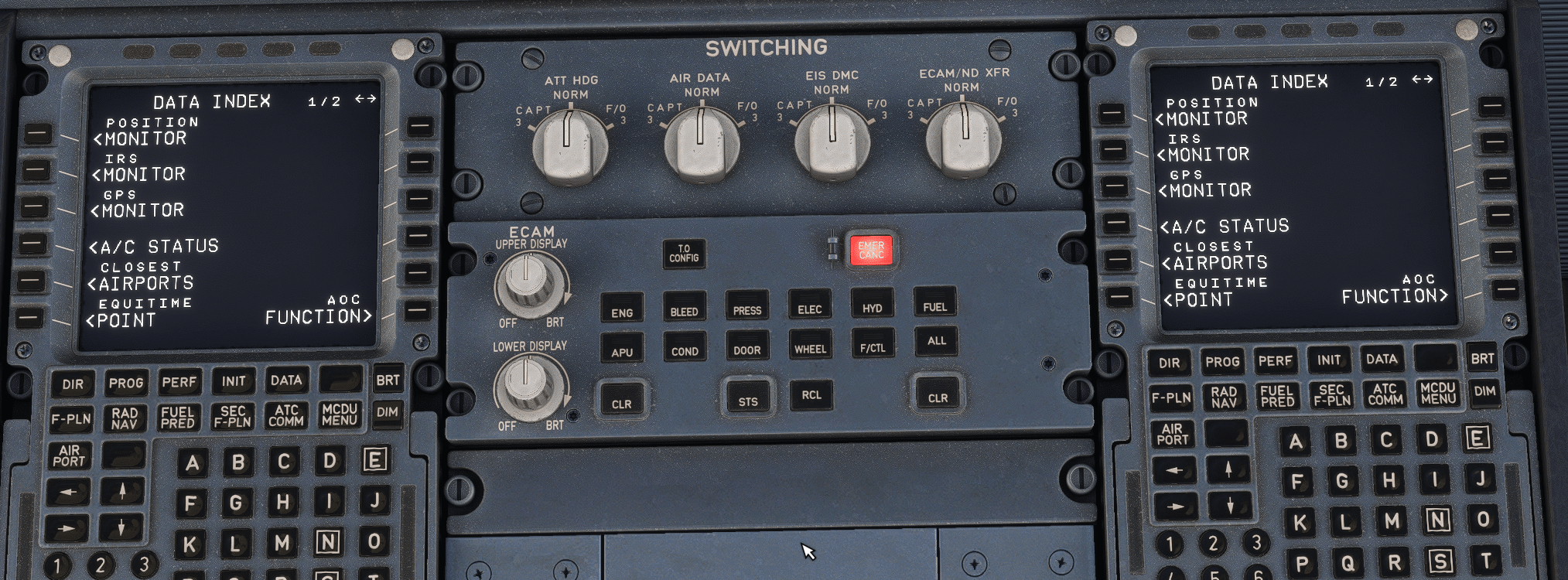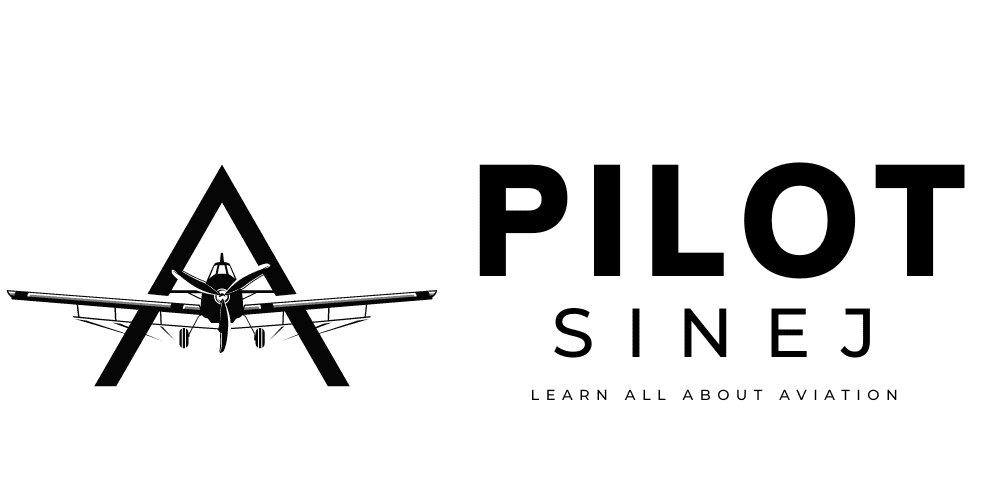Category: A320 Systems / Technical Training
Estimated Reading Time: 9–10 minutes
What Is the A320 Switching Panel?
On the Airbus A320 flight deck, a small but vital control unit sits just below the ECAM Control Panel on the center pedestal — the Switching Panel. Its purpose is simple yet critical: it allows pilots to manually reassign data sources and display computers within the Electronic Instrument System (EIS) if automatic reconfiguration fails.
According to the Airbus A320 FCOM (DSC-31-30), this panel provides the crew with a direct means to maintain essential flight, navigation, and engine data by selecting alternate sources. In normal operations, every selector stays in NORM, but during failures it can quickly restore blank displays or incorrect data — keeping the aircraft fully controllable and the crew informed.
Key Takeaways — Airbus A320 Switching Panel
How the A320 Switching Panel Works (EIS Overview)
The Electronic Instrument System (EIS) is the visual backbone of the Airbus A320 flight deck. It combines two major sub-systems:
- EFIS (Electronic Flight Instrument System) – provides flight and navigation data via the Primary Flight Displays (PFDs) and Navigation Displays (NDs).
- ECAM (Electronic Centralized Aircraft Monitor) – presents system status, warnings, and engine data on two Display Units (E/WD and SD).
Each A320 has six identical Display Units (DUs), driven by three Display Management Computers (DMC1, DMC2, DMC3).
| Display Unit | Typical Function | Normal Source |
|---|---|---|
| Captain PFD | Flight guidance | DMC1 |
| Captain ND | Navigation | DMC1 |
| F/O PFD | Flight guidance | DMC2 |
| F/O ND | Navigation | DMC2 |
| E/WD | Engine & warnings | DMC3 |
| SD | System pages | DMC3 |
Under normal conditions, DMC1 drives the captain’s displays, DMC2 the first officer’s, and DMC3 the ECAM screens. If one fails, the Switching Panel allows manual reassignment — ensuring no essential display is lost.

Practice single-switch actions and confirm results before making further changes.
Layout and Components of the Switching Panel
Located on the center pedestal, the A320 Switching Panel contains four rotary selectors and, depending on configuration, one pushbutton. Each control is spring-loaded to NORM and used only when abnormal or failure conditions occur.
The Four Main Selectors
| Selector | Controls | Normal Position | Used When |
|---|---|---|---|
| EIS DMC | Determines which DMC feeds the captain’s or F/O’s PFD/ND | NORM | Set to CAPT 3 or F/O 3 if DMC1 or DMC2 fails |
| ATT/HDG | Selects alternate Inertial Reference (IR) source | NORM | Used if an IR fails |
| AIR DATA | Selects alternate Air Data Reference (ADR) source | NORM | Used if an ADR fails |
| ECAM/ND XFR | Transfers ECAM display to an ND | NORM | Used if an ECAM DU fails |
An optional PFD/ND XFR pushbutton can be installed, allowing the pilot to swap PFD and ND positions on the same side.
The EIS DMC Selector
This selector governs which Display Management Computer drives each pilot’s display. In normal operation, DMC1 powers the captain’s displays and DMC2 the first officer’s.

If DMC1 fails, the captain’s PFD and ND go blank. The pilot sets EIS DMC → CAPT 3, transferring data from DMC3 to those displays. DMC3 now drives both ECAM and the captain’s instruments until maintenance action.
The ATT/HDG and AIR DATA Selectors
The ATT/HDG and AIR DATA selectors control which ADIRS (Air Data and Inertial Reference System) channel provides data to each pilot’s displays.
- ATT/HDG Selector: switches IR (Inertial Reference) source for attitude and heading data.
- AIR DATA Selector: switches ADR (Air Data Reference) source for airspeed, altitude, and pressure data.
If IR1 fails, the captain can set the ATT/HDG CAPT 3 position to take IR3 data. If ADR1 fails, the AIR DATA CAPT 3 position will draw data from ADR3. According to the Airbus A320 FCTM (23-Aug-2023), these manual selections ensure pilots maintain reliable attitude and airspeed references when the automatic cross-channel logic cannot compensate.
ECAM/ND Transfer Logic
When either ECAM screen fails, the ECAM/ND XFR selector lets the crew display ECAM data on a Navigation Display. For example, if the lower ECAM (SD) fails, the pilot moves the selector, and the right ND temporarily shows ECAM system pages. The other ND remains dedicated to navigation to maintain situational awareness.
This flexibility ensures essential ECAM warnings and system data are always visible — even with multiple display unit failures.
Operational Restrictions and Cautions
From the Airbus A320 AFM (02-Apr-2025, ABN-22 CAT II/III):
Switching actions must not be performed below 1000 ft RA during CAT II or CAT III operations.
This limitation prevents display or data reconfiguration that could disrupt autopilot or autoland functions during critical phases of flight. All switching actions should be completed well before the final approach segment.
Additional crew cautions include avoiding multiple switch changes at once, verifying correct data sources after switching, and cross-checking PFD/ND indications with the standby instrument (ISIS).
Practical Failure Scenarios and Crew Actions
Display Management Computer Failure
When a DMC fails, the associated displays go blank. Use the EIS DMC selector to transfer those screens to DMC3. The ECAM may momentarily reconfigure while sharing workload.
Air Data or IR Failure
If an ADR or IR unit fails, select another data source using ATT/HDG or AIR DATA selectors. Cross-check standby instruments to confirm correct readings.
ECAM Display Failure
If the E/WD or SD goes blank, use ECAM/ND XFR to view ECAM data on an ND. Ensure one pilot retains navigation display capability.
Why the Switching Panel Matters
The switching panel represents Airbus’s human-centered automation philosophy: automation should manage complexity, but the pilot must always have the ability to intervene.
- Redundancy: Keeps flight and engine displays active even after multiple faults.
- Situational Awareness: Ensures data availability to both pilots.
- Flexibility: Provides manual control over data sources when automatic reconfiguration is not sufficient.
- Maintenance Aid: Helps engineers isolate faults during troubleshooting.
In the Simulator and Training Context
Airbus type-rating programs often include practical exercises on Switching Panel operation. Instructors may simulate DMC, IR, or ADR failures and evaluate how the crew handles the reconfiguration.
Typical training drills include:
- DMC1 failure: Captain routes displays to DMC3 using EIS DMC selector.
- IR failure: Crew selects alternate IR via ATT/HDG switch.
- ECAM DU failure: Transfer ECAM display to ND for system monitoring.

The A320 FCTM emphasizes discipline: one pilot flies the aircraft while the other performs the switching and confirms correct indications.
Airbus Design Philosophy in Comparison
Compared to Boeing aircraft — where display reversion is often automated — the Airbus A320 allows manual, deliberate control of data routing.
| Feature | Airbus A320 | Boeing 737 |
|---|---|---|
| Display Management | Manual via EIS DMC Selector | Automatic by Display Processor Unit |
| IR/ADR Source Selection | Manual with ATT/HDG and AIR DATA switches | Automatic IRS/ADC reversion |
| ECAM vs EICAS | Manual ECAM/ND transfer | Automatic EICAS reversion |
| Approach Limitation | No switching below 1000 ft CAT II/III | Similar restriction applies |
| Design Philosophy | Pilot-directed flexibility | System-driven automation |
Related Topics to Explore
- A320 ECAM System Overview
- Display Management Computers (DMCs)
- A320 Air Data and Inertial Reference System
- A320 Flight Deck Layout
- A320 EFIS Explained
Summary
The A320 Switching Panel may be small, but its role in system redundancy is massive. By allowing pilots to manually control data and display sourcing, it ensures continuous situational awareness and flight data integrity under abnormal conditions.
- Controls data and display sourcing for EIS.
- Contains EIS DMC, ATT/HDG, AIR DATA, and ECAM/ND XFR selectors.
- Normally all selectors remain in NORM.
- Not to be used below 1000 ft during CAT II/III operations.
- Essential for type-rating training and system failure management.
| Selector | Main Function | Failure Scenario |
|---|---|---|
| EIS DMC | Switches display computer input | DMC failure or blank screen |
| ATT/HDG | Selects alternate IR source | Inertial data failure |
| AIR DATA | Selects alternate ADR source | Air data failure |
| ECAM/ND XFR | Moves ECAM to ND | ECAM DU failure |
From the Airbus FCOM (11-Oct-2023):
“The switching panel enables the crew to maintain essential indications through manual source and display reconfiguration in case of system degradation.”
Frequently Asked Questions: Airbus A320 Switching Panel
What is the A320 switching panel used for?
The A320 switching panel allows pilots to manually reconfigure the Electronic Instrument System (EIS) when automatic reconfiguration is insufficient.It lets the crew select alternate data or display sources — such as changing which Display Management Computer (DMC) drives a screen or which Inertial Reference (IR) or Air Data (ADR) source feeds the instruments.
Where is the switching panel located on the A320 flight deck?
The switching panel is located on the center pedestal, just below the ECAM control panel.
It is easily accessible to both pilots and typically consists of four rotary selectors and an optional pushbutton.
What are the four selectors on the A320 switching panel?
- EIS DMC: Selects which Display Management Computer drives the captain or first officer’s displays.
- ATT/HDG: Selects the Inertial Reference (IR) source for attitude and heading.
- AIR DATA: Chooses the Air Data Reference (ADR) source for airspeed, altitude, and pressure data.
- ECAM/ND XFR: Transfers ECAM information to a Navigation Display if an ECAM screen fails.
When should the switching panel be used?
The switching panel should only be used during abnormal conditions, such as a DMC, IR, or ADR failure.
In all normal operations, the selectors must remain in NORM.
Airbus procedures specify that switching should not be performed during critical flight phases unless necessary for safety.
Can pilots use the switching panel during CAT II or CAT III approaches?
No. According to the A320 AFM, no switching actions should be made below 1000 ft radio altitude during CAT II or CAT III operations.
Switching during this phase could interfere with the autopilot, autoland, or flight guidance systems.
What happens if a DMC fails?
If DMC1 or DMC2 fails, the affected side’s displays (PFD/ND) go blank.
The pilot can use the EIS DMC selector to reroute that side’s displays to DMC3, restoring data from a healthy source.
What is the ECAM/ND XFR function?
The ECAM/ND XFR selector allows the crew to move ECAM information onto a Navigation Display (ND) if one of the ECAM Display Units fails.
This ensures the pilots always have access to system and warning information.
How is the switching panel used during simulator training?
In Airbus type-rating or recurrent training, instructors simulate failures such as DMC, IR, or ADR faults.
The switching panel is used to practice manual reconfiguration – helping crews develop procedural discipline and teamwork under abnormal conditions.
Why does Airbus include a manual switching panel when reconfiguration can be automatic?
The A320’s switching panel gives pilots ultimate control over their data sources.
While automatic reconfiguration covers most scenarios, Airbus philosophy emphasizes that the crew must have the ability to manually select alternate sources if automation cannot handle specific fault combinations.
Are all A320 aircraft equipped with a PFD/ND XFR button?
Not all. The PFD/ND XFR pushbutton is an optional feature that allows swapping the positions of the PFD and ND on the same side.
It’s available on some A320 configurations but not all operators choose to install it.
